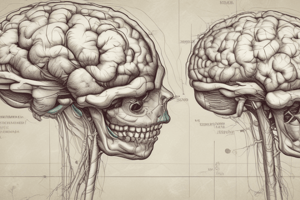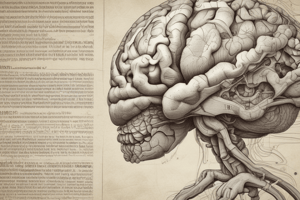Podcast
Questions and Answers
What is the primary function of the corpus callosum?
What is the primary function of the corpus callosum?
- To regulate emotional responses and memory formation
- To facilitate interhemispheric communication and integrate information between the two hemispheres (correct)
- To control bilateral motor movements
- To process and integrate sensory information from one side of the body
What is the approximate number of nerve fibers in the corpus callosum?
What is the approximate number of nerve fibers in the corpus callosum?
- 300-350 million
- 200-250 million (correct)
- 100-150 million
- 400-450 million
Which part of the corpus callosum is responsible for connecting the two hemispheres?
Which part of the corpus callosum is responsible for connecting the two hemispheres?
- Splenium
- Rostrum
- Body (correct)
- Genu
What is an example of a neurodevelopmental disorder that affects the corpus callosum?
What is an example of a neurodevelopmental disorder that affects the corpus callosum?
What is an example of a higher-level cognitive function that the corpus callosum is involved in?
What is an example of a higher-level cognitive function that the corpus callosum is involved in?
What is a characteristic of neuroplasticity in the corpus callosum?
What is a characteristic of neuroplasticity in the corpus callosum?
What is a result of impaired interhemispheric communication due to neurodevelopmental disorders?
What is a result of impaired interhemispheric communication due to neurodevelopmental disorders?
What is an example of a function that the corpus callosum is involved in, besides interhemispheric communication?
What is an example of a function that the corpus callosum is involved in, besides interhemispheric communication?
Where is the corpus callosum located in the brain?
Where is the corpus callosum located in the brain?
The corpus callosum contains only homotopic fibers.
The corpus callosum contains only homotopic fibers.
What is the name of the syndrome that results from damage to the corpus callosum?
What is the name of the syndrome that results from damage to the corpus callosum?
The corpus callosum begins to develop during the __________ week of fetal life.
The corpus callosum begins to develop during the __________ week of fetal life.
Match the parts of the corpus callosum with their descriptions:
Match the parts of the corpus callosum with their descriptions:
The corpus callosum reaches its full functional capacity in early childhood.
The corpus callosum reaches its full functional capacity in early childhood.
Flashcards are hidden until you start studying
Study Notes
Neuroanatomy
- The corpus callosum is the largest white matter structure in the brain, connecting the two hemispheres.
- It is composed of approximately 200-250 million nerve fibers.
- The corpus callosum is divided into four parts:
- Rostrum: The anterior (front) part of the corpus callosum.
- Genu: The curvature of the corpus callosum that connects the rostrum to the body.
- Body: The largest part of the corpus callosum, responsible for connecting the two hemispheres.
- Splenium: The posterior (back) part of the corpus callosum.
- The corpus callosum is responsible for integrating sensory, motor, and cognitive information between the two hemispheres.
Brain Function
- The corpus callosum plays a crucial role in interhemispheric communication, enabling the integration of information between the two hemispheres.
- It facilitates:
- Bilateral coordination of motor movements
- Integration of sensory information from both sides of the body
- Higher-level cognitive functions, such as:
- Language processing
- Problem-solving
- Attention
- The corpus callosum is also involved in:
- Emotional processing and regulation
- Memory formation and retrieval
- Spatial awareness and processing
Neuroplasticity
- The corpus callosum is capable of reorganizing itself in response to changes in the brain or environment.
- Neuroplasticity in the corpus callosum is evident in:
- Compensation for brain damage or lesions
- Adaptation to changes in sensory or motor inputs
- Learning and memory formation
- The corpus callosum can also be affected by neurodevelopmental disorders, such as:
- Aggenesis of the corpus callosum (ACC), where the structure is partially or completely absent
- Callosal dysgenesis, where the structure is malformed or disrupted
- These disorders can lead to impaired interhemispheric communication, resulting in cognitive and behavioral deficits.
Neuroanatomy
- The corpus callosum is the largest white matter structure in the brain, composed of approximately 200-250 million nerve fibers.
- It is divided into four parts: rostrum, genu, body, and splenium.
- The corpus callosum connects the two hemispheres, integrating sensory, motor, and cognitive information.
Brain Function
- The corpus callosum enables interhemispheric communication, facilitating bilateral coordination of motor movements and integration of sensory information.
- It supports higher-level cognitive functions, including language processing, problem-solving, and attention.
- The corpus callosum is also involved in emotional processing and regulation, memory formation and retrieval, and spatial awareness and processing.
Neuroplasticity
- The corpus callosum can reorganize itself in response to changes in the brain or environment, demonstrating neuroplasticity.
- This adaptability is evident in compensation for brain damage or lesions, adaptation to changes in sensory or motor inputs, and learning and memory formation.
- The corpus callosum can be affected by neurodevelopmental disorders, such as agenesis of the corpus callosum (ACC) and callosal dysgenesis, leading to impaired interhemispheric communication and cognitive and behavioral deficits.
Neuroanatomy of the Corpus Callosum
Location and Structure
- Located at the base of the longitudinal fissure, which separates the two cerebral hemispheres in the brain
- Divided into four parts: rostrum, genu, body, and splenium
Functions
- Integrates sensory, motor, and cognitive information between the two hemispheres
- Facilitates interhemispheric communication, allowing for coordination of bilateral functions such as:
- Movement
- Sensation
- Cognition
Fiber Composition
- Contains approximately 300 million nerve fibers
- Fibers are divided into three types:
- Homotopic fibers: connect identical areas of the two hemispheres
- Heterotopic fibers: connect different areas of the two hemispheres
- Commissural fibers: connect the two hemispheres and facilitate interhemispheric communication
Development and Maturation
- Begins to develop during the 12th week of fetal life
- Continues to mature and develop throughout childhood and adolescence
- Reaches full functional capacity in early adulthood
Clinical Significance
- Damage can result in split-brain syndrome, characterized by a lack of coordination between the two hemispheres
- Often affected in neurological disorders such as:
- Alzheimer's disease
- Parkinson's disease
- Multiple sclerosis
Studying That Suits You
Use AI to generate personalized quizzes and flashcards to suit your learning preferences.



